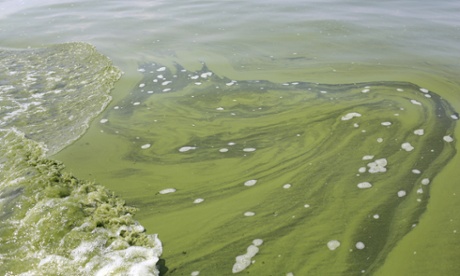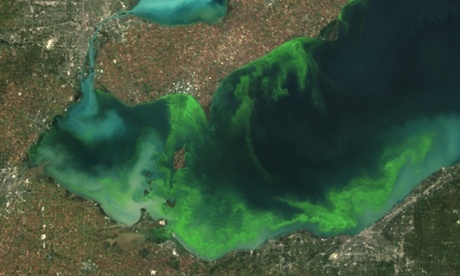
A water ban that had hundreds of thousands of people in Ohio and Michigan scrambling for drinking water has been lifted, Toledo’s mayor announced Monday.
Mayor D Michael Collins lifted the ban at a Monday morning news conference, and said the city’s drinking water is safe.
Ohio’s fourth-largest city warned residents not to use city water early Saturday after tests at one treatment plant showed readings for microcystin above the standard for consumption, most likely from algae on the lake. Ohio Governor John Kasich declared a state of emergency.
Early Monday, Collins kept in place an advisory against drinking or using the water pending additional tests. At a 3am news conference, Collins said it was his decision to keep the advisory in place at least into the morning hours, even though latest test results suggest the algae-induced toxin contaminating Lake Erie had probably dissipated to safe levels. The mayor said two tests had come back “too close for comfort”.
With the warning, worried residents told not to drink, brush their teeth or wash dishes with the water descended on truckloads of bottled water delivered from across the state. The Ohio national guard was using water purification systems to produce drinkable water.
Oliver Arnold, of Toledo, loaded up on bottled water Sunday so that he could give baths to his six children, including four-month-old twins. “We’re going through a lot. I know by tomorrow, we’re going to be looking for water again,” he said.
Some hospitals canceled elective surgeries and were sending surgical equipment that needed sterilized to facilities outside the water emergency, said Bryan Biggie, disaster coordinator for ProMedica hospitals inToledo.
In south-eastern Michigan, authorities were operating water stations Sunday for the 30,000 customers affected by the toxic contamination.
Drinking the water could cause vomiting, cramps and rashes. But no serious illnesses had been reported by late Sunday. Health officials advised children and those with weak immune systems to avoid showering or bathing in the water.
Amid the emergency, discussion began to center around how to stop the pollutants fouling the lake that supplies drinking water for 11 million people.
“People are finally waking up to the fact that this is not acceptable,” Collins said.

The toxins that contaminated the region’s drinking water supply didn’t just suddenly appear.
Water plant operators along western Lake Erie have long been worried about this very scenario as a growing number of algae blooms have turned the water into a pea soup color in recent summers, leaving behind toxins that can sicken people and kill pets.
In fact, the problems on the shallowest of the five Great Lakes brought on by farm runoff and sludge from sewage treatment plants have been building for more than a decade.
The National Oceanic and Atmospheric Administration released a satellite image showing a small but concentrated algae bloom centered right where Toledo draws its water supply, said Jeff Reutter, head of the Ohio Sea Grant research lab.
The bloom was much smaller than in past years and isn’t expected to peak until early September. But instead of being pushed out to the middle of the lake, winds and waves drove the algae toward the shore, he said.
“Weather conditions made it such that bloom was going right into the water intakes,” said Reutter, who has been studying the lake since the 1970s, when it was severely polluted.
The amount of phosphorus going into the lake has risen every year since the mid-1990s. “We’re right back to where we were in the 70s,” Reutter said.
Almost a year ago, one township just east of Toledo told its 2,000 residents not to drink or use the water coming from their taps. That was believed to be the first time a city has banned residents from using the water because of toxins from algae in the lake.

Researchers largely blame the algae’s resurgence on manure and chemical fertilizer from farms that wash into the lake along with sewage treatment plants. Leaky septic tanks and stormwater drains have contributed, too. Combined, they flush huge amounts of phosphorus into the lake.
Environmental groups and water researchers have been calling on Ohio and other states in the Great Lakes region to drastically reduce the amount of phosphorus flowing into the lake. Ohio lawmakers this past spring took a step toward tackling the algae problem when they enacted a law requiring most farmers to undergo training before they use commercial fertilizers on their fields. But they have stopped short of mandating restrictions on farmers.
The International Joint Commission, an advisory agency made up of Canadian and US officials, said last year urgent steps are needed to reduce phosphorus applied to fields, suggesting among other things that states ban the spread of manure on frozen or snow-covered ground.
That report came after a state task force in Ohio called for a 40% reduction in all forms of phosphorus going into the lake.
Agriculture industry groups have been asking farmers for more than a year to reduce phosphorus runoff before government regulators step in and impose their own restrictions.
“We’re clearly showing progress,” Reutter said. “You have to decide for yourself whether you think it’s fast enough.”
In Michigan, Detroit’s four million-user water system gets its water from Lake Huron and the Detroit River. In the face of the Toledo water crisis, Detroit officials plan to review their contamination procedures Monday, water department Deputy Director Darryl Latimer told The Detroit News. He said it was unlikely Detroit would face a problem like Toledo’s.
“The system is tested every two weeks for blue-green algae,” Latimer said. “We haven’t seen the precursors for this type of toxin.
